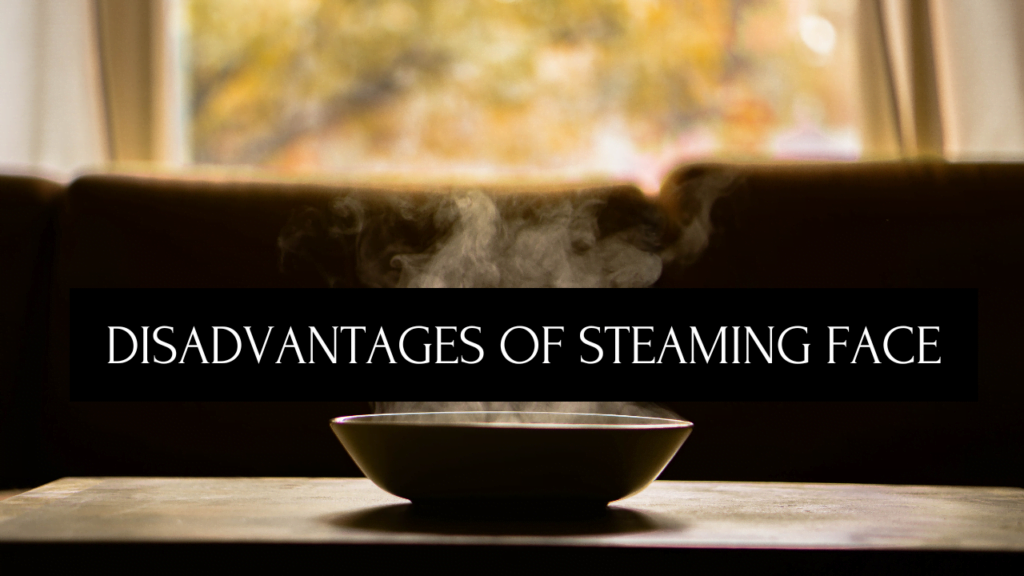
The Hidden Downsides of Facial Steaming
What are the Disadvantages of Steaming Face? Facial steaming is often praised for its benefits, including deep pore cleansing and enhanced circulation. However, there are notable disadvantages that are frequently overlooked. This comprehensive guide delves into the potential downsides of steaming your face, offering insights and precautions to ensure your skincare routine remains safe and effective.
Facial steaming, a popular skincare practice, is lauded for opening pores, cleansing the skin, and improving blood circulation. Yet, as with any beauty treatment, it’s essential to understand both the benefits and the potential drawbacks. While steaming can indeed enhance your skincare regimen, it’s not without its risks. This article will explore the disadvantages of steaming your face, providing you with a balanced view to make informed decisions about your skincare routine.
Understanding Facial Steaming
Facial steaming involves exposing the face to steam, typically from hot water, to loosen dirt and debris from pores. This practice dates back to ancient times and is known for its rejuvenating effects. However, it’s crucial to recognize that improper use or overuse can lead to several skin issues.
Disadvantages of Steaming Face
Risk of Burns and Scalds
One of the most immediate risks of facial steaming is burns and scalds. Hot steam can cause severe damage to the delicate facial skin if not done correctly. Maintaining a safe distance from the steam source and ensuring the water isn’t too hot are critical steps to prevent such injuries.
Increased Skin Sensitivity
Frequent steaming can increase skin sensitivity. The heat from the steam can strip away the natural oils that protect your skin, leading to heightened sensitivity. This can make your skin more susceptible to irritation, redness, and reactions to skincare products.
Dryness and Dehydration
While steam can hydrate the skin temporarily, excessive steaming can lead to dryness. The heat can deplete your skin’s moisture barrier, resulting in flaky, dry skin. This is particularly problematic for individuals with naturally dry or sensitive skin types.
Aggravation of Skin Conditions
For those with pre-existing skin conditions like eczema, rosacea, or acne, steaming can aggravate symptoms. The heat and moisture can trigger flare-ups, worsening the condition instead of providing relief. Consulting with a dermatologist before incorporating steaming into your routine is advisable if you have such conditions.
Broken Capillaries
Exposure to high heat can cause capillaries close to the skin’s surface to burst, leading to red, spider-like veins known as broken capillaries. This is especially a concern for individuals with thin or sensitive skin, where capillaries are more fragile.
Overstimulation of Sebaceous Glands
Steaming can overstimulate sebaceous glands, leading to an overproduction of oil. This can exacerbate acne and lead to clogged pores, counteracting the intended benefits of the steam.
Allergic Reactions to Added Ingredients
Many people add essential oils or herbs to their steam water for added benefits. However, these ingredients can cause allergic reactions or skin irritation in some individuals. It’s essential to test any new additions on a small skin area first.
Maintaining a Balanced Approach
While facial steaming has its disadvantages, it doesn’t mean you have to eliminate it from your skincare routine entirely. Here are some tips to enjoy the benefits of steaming while minimising the risks:
Moderation is Key
Limit steaming sessions to once a week or less to avoid over-exposure to heat. This helps in maintaining the skin’s natural moisture balance and reduces the risk of sensitivity.
Proper Distance and Temperature
Keep your face at a safe distance from the steam source—about 12-18 inches—and ensure the water is warm, not boiling. This minimises the risk of burns and scalds.
Hydration Post-Steam
Always follow up a steaming session with a good moisturiser to replenish lost moisture. Using a hydrating mask can also help restore skin hydration levels.
Consult a Dermatologist
If you have sensitive skin or any skin conditions, consult a dermatologist before adding steaming to your routine. They can provide personalised advice and alternatives that suit your skin type.
Alternative Methods for Skin Care
Consider alternative methods that provide similar benefits without the potential risks. For example, using gentle exfoliants or hydrating masks can help maintain clear and hydrated skin.
Disadvantages of Steaming Face
Facial steaming can lead to various skin issues if not done correctly. From burns and increased sensitivity to dehydration and broken capillaries, understanding these risks can help you avoid potential harm. Incorporating safe practices and consulting skincare professionals can help you enjoy the benefits of steaming without compromising your skin’s health.
FAQs
How often should I steam my face to avoid the disadvantages?
Steaming your face once a week is generally sufficient. Overdoing it can lead to skin issues such as dryness and sensitivity.
Can steaming worsen acne?
Yes, steaming can worsen acne by overstimulating oil production and aggravating existing breakouts. It’s best to consult a dermatologist if you have acne-prone skin.
Is it safe to add essential oils to the steam water?
While essential oils can provide added benefits, they can also cause allergic reactions. Always perform a patch test before using any new oils in your steam water.
What should I do if I experience redness or irritation after steaming?
If you experience redness or irritation, stop steaming immediately and apply a soothing moisturizer or aloe vera gel. If the irritation persists, consult a dermatologist.
Can facial steaming help with blackheads?
Steaming can help loosen blackheads, making them easier to remove. However, it should be done carefully and followed by gentle extraction methods.
Are there any safer alternatives to facial steaming?
Yes, safer alternatives include using gentle exfoliants, hydrating masks, and regular cleansing to maintain healthy skin without the risks associated with steaming.
Conclusion
Facial steaming, while beneficial, comes with several potential disadvantages that must be acknowledged and mitigated. By understanding the risks and taking appropriate precautions, you can incorporate steaming into your skincare routine safely and effectively. Always prioritize your skin’s health and consult with professionals when in doubt to ensure your beauty regimen enhances rather than harms your skin.